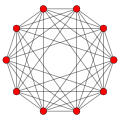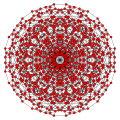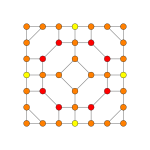Cantellated 5-cubes
 5-cube |
 Cantellated 5-cube |
 Bicantellated 5-cube |
 Cantellated 5-orthoplex |
 5-orthoplex |
 Cantitruncated 5-cube |
 Bicantitruncated 5-cube |
 Cantitruncated 5-orthoplex |
| Orthogonal projections in B5 Coxeter plane | |||
|---|---|---|---|
In six-dimensional geometry, a cantellated 5-cube is a convex uniform 5-polytope, being a cantellation of the regular 5-cube.
There are 6 unique cantellation for the 5-cube, including truncations. Half of them are more easily constructed from the dual 5-orthoplex
Cantellated 5-cube[edit]
| Cantellated 5-cube | ||
| Type | Uniform 5-polytope | |
| Schläfli symbol | rr{4,3,3,3} = | |
| Coxeter-Dynkin diagram | ||
| 4-faces | 122 | 10 80 32 |
| Cells | 680 | 40 320 160 160 |
| Faces | 1520 | 80 480 320 640 |
| Edges | 1280 | 320+960 |
| Vertices | 320 | |
| Vertex figure | ||
| Coxeter group | B5 [4,3,3,3] | |
| Properties | convex, uniform | |
Alternate names[edit]
- Small rhombated penteract (Acronym: sirn) (Jonathan Bowers)
Coordinates[edit]
The Cartesian coordinates of the vertices of a cantellated 5-cube having edge length 2 are all permutations of:
Images[edit]
| Coxeter plane | B5 | B4 / D5 | B3 / D4 / A2 |
|---|---|---|---|
| Graph | 
|

|

|
| Dihedral symmetry | [10] | [8] | [6] |
| Coxeter plane | B2 | A3 | |
| Graph | 
|

| |
| Dihedral symmetry | [4] | [4] |
Bicantellated 5-cube[edit]
| Bicantellated 5-cube | ||
| Type | Uniform 5-polytope | |
| Schläfli symbols | 2rr{4,3,3,3} = r{32,1,1} = | |
| Coxeter-Dynkin diagrams | ||
| 4-faces | 122 | 10 80 32 |
| Cells | 840 | 40 240 160 320 80 |
| Faces | 2160 | 240 320 960 320 320 |
| Edges | 1920 | 960+960 |
| Vertices | 480 | |
| Vertex figure | 
| |
| Coxeter groups | B5, [3,3,3,4] D5, [32,1,1] | |
| Properties | convex, uniform | |
In five-dimensional geometry, a bicantellated 5-cube is a uniform 5-polytope.
Alternate names[edit]
- Bicantellated penteract, bicantellated 5-orthoplex, or bicantellated pentacross
- Small birhombated penteractitriacontiditeron (Acronym: sibrant) (Jonathan Bowers)
Coordinates[edit]
The Cartesian coordinates of the vertices of a bicantellated 5-cube having edge length 2 are all permutations of:
- (0,1,1,2,2)
Images[edit]
| Coxeter plane | B5 | B4 / D5 | B3 / D4 / A2 |
|---|---|---|---|
| Graph | 
|

|

|
| Dihedral symmetry | [10] | [8] | [6] |
| Coxeter plane | B2 | A3 | |
| Graph | 
|

| |
| Dihedral symmetry | [4] | [4] |
Cantitruncated 5-cube[edit]
| Cantitruncated 5-cube | ||
| Type | Uniform 5-polytope | |
| Schläfli symbol | tr{4,3,3,3} = | |
| Coxeter-Dynkin diagram |
||
| 4-faces | 122 | 10 80 32 |
| Cells | 680 | 40 320 160 160 |
| Faces | 1520 | 80 480 320 640 |
| Edges | 1600 | 320+320+960 |
| Vertices | 640 | |
| Vertex figure | 
| |
| Coxeter group | B5 [4,3,3,3] | |
| Properties | convex, uniform | |
Alternate names[edit]
- Tricantitruncated 5-orthoplex / tricantitruncated pentacross
- Great rhombated penteract (girn) (Jonathan Bowers)
Coordinates[edit]
The Cartesian coordinates of the vertices of a cantitruncated 5-cube having an edge length of 2 are given by all permutations of coordinates and sign of:
Images[edit]
| Coxeter plane | B5 | B4 / D5 | B3 / D4 / A2 |
|---|---|---|---|
| Graph | 
|

|

|
| Dihedral symmetry | [10] | [8] | [6] |
| Coxeter plane | B2 | A3 | |
| Graph | 
|

| |
| Dihedral symmetry | [4] | [4] |
Related polytopes[edit]
It is third in a series of cantitruncated hypercubes:
 
|
 
|
 
|
 
|
 
|
 
|
| Truncated cuboctahedron | Cantitruncated tesseract | Cantitruncated 5-cube | Cantitruncated 6-cube | Cantitruncated 7-cube | Cantitruncated 8-cube |
Bicantitruncated 5-cube[edit]
| Bicantitruncated 5-cube | ||
|---|---|---|
| Type | uniform 5-polytope | |
| Schläfli symbol | 2tr{3,3,3,4} = t{32,1,1} = | |
| Coxeter-Dynkin diagrams | ||
| 4-faces | 122 | 10 80 32 |
| Cells | 840 | 40 240 160 320 80 |
| Faces | 2160 | 240 320 960 320 320 |
| Edges | 2400 | 960+480+960 |
| Vertices | 960 | |
| Vertex figure | 
| |
| Coxeter groups | B5, [3,3,3,4] D5, [32,1,1] | |
| Properties | convex, uniform | |
Alternate names[edit]
- Bicantitruncated penteract
- Bicantitruncated pentacross
- Great birhombated penteractitriacontiditeron (Acronym: gibrant) (Jonathan Bowers)
Coordinates[edit]
Cartesian coordinates for the vertices of a bicantitruncated 5-cube, centered at the origin, are all sign and coordinate permutations of
- (±3,±3,±2,±1,0)
Images[edit]
| Coxeter plane | B5 | B4 / D5 | B3 / D4 / A2 |
|---|---|---|---|
| Graph | 
|

|

|
| Dihedral symmetry | [10] | [8] | [6] |
| Coxeter plane | B2 | A3 | |
| Graph | 
|

| |
| Dihedral symmetry | [4] | [4] |
Related polytopes[edit]
These polytopes are from a set of 31 uniform 5-polytopes generated from the regular 5-cube or 5-orthoplex.
References[edit]
- H.S.M. Coxeter:
- H.S.M. Coxeter, Regular Polytopes, 3rd Edition, Dover New York, 1973
- Kaleidoscopes: Selected Writings of H.S.M. Coxeter, editied by F. Arthur Sherk, Peter McMullen, Anthony C. Thompson, Asia Ivic Weiss, Wiley-Interscience Publication, 1995, ISBN 978-0-471-01003-6 [1]
- (Paper 22) H.S.M. Coxeter, Regular and Semi Regular Polytopes I, [Math. Zeit. 46 (1940) 380-407, MR 2,10]
- (Paper 23) H.S.M. Coxeter, Regular and Semi-Regular Polytopes II, [Math. Zeit. 188 (1985) 559-591]
- (Paper 24) H.S.M. Coxeter, Regular and Semi-Regular Polytopes III, [Math. Zeit. 200 (1988) 3-45]
- Norman Johnson Uniform Polytopes, Manuscript (1991)
- N.W. Johnson: The Theory of Uniform Polytopes and Honeycombs, Ph.D.
- Klitzing, Richard. "5D uniform polytopes (polytera)". o3o3x3o4x - sirn, o3x3o3x4o - sibrant, o3o3x3x4x - girn, o3x3x3x4o - gibrant
External links[edit]
- Glossary for hyperspace, George Olshevsky.
- Polytopes of Various Dimensions, Jonathan Bowers
- Runcinated uniform polytera (spid), Jonathan Bowers
- Multi-dimensional Glossary







































